One of my
neighbours' daughter threw a party and
cranked up the volume of daddy's stereo and fried
the voice coil on one of the Philips 9710 drivers
in these vintage Sonab OA5 speakers. He
had bought these speakers at the local second
hand market - he was there before me - and had
come to like the vivid presentation of these
high-efficiency, easy driven speakers of the
Seventies.
So, he googled "Philips
9710" and the connection
was made. From eBay he had bought a pair of
9710s from Germany and one of the drivers was
suitable for restoration. The other had had some
surround repair - too much white PVA glue - and a
resulting Fs of some 90 Hz. Too bad, but that's
how goes buying on eBay from second hand dealers
knowing nothing about loudspeakers.
The Sonab range of
speakers from the Seventies are speakers
I've long been looking for in order to find out
what the 9710 could do in an omnidirectional
set-up, and this OA5-mkII did call for a few
surprises.
First of all I
assume this is a Sonab OA5 mkII from
reading the excellent website on these speakers:
http://www.carlssonplanet.com/oa5ii.php
The technical data suggests the following:
Volume: 47 liter
Dimensions: 24 x 61 x 43 cm
Weight: 10 kgs
Principle: Omni-directional bas-reflex loaded
speaker (although it does not have port tubes,
see later)
Impedance: 7 ohms
Frequency range: 37-18,000 Hz
Crossover frequency: 2,700 Hz
Bass/mid: Philips 9710
Treble units: Peerless MT 20 HFC
This is all fully in
accordance with my findings, except for
the 37 Hz bass extension. The speakers have no
Sonab badges and taking them apart made me wonder
whether this is really a commercial product or
some cleaver cloning of the same. I believe this is
a true Sonab product from the cabinet work, but
the 9710 basket and the crossover PCB suggests
amateur work.
The principles of these
speakers can be found on the
carlssonplanet website and I won't get into
details with this, but the cabinet calls for some
comments. Take a look a the photos below. What is
this? A 47 liter cabinet with the 9710 driver
placed in a metal mesh basket with some heavy
glassfiber material between driver and mesh,
making a low-pass filter that can be adjusted due
to the basket being suspended on three screws
that allows you to increase or decrease the
acoustic resistance of the fiber material. An
acoustic vent, sort of. Something similar can be
found on some Lowther drivers. Next we have a
cabinet divided into two compartments by two
heavy fiberglass sheets. The lower compartment is
open to the outside by two 54 mm holes at the
bottom, no tubes here. In reality I guess we can
call this a two-step aperiodic system with
progressively diminishing acoustic resistance
towards lower frequences. What is sure is this: I
have never seen a more valve-amp friendly
impedance than this, only varying 7 to 10 ohms
from 20 to 1000 Hz! Take that! Consequently phase
angles are modest, not to say almost flat.
Overall sensitivity is around 90 dB/2.8 volts
taken from the midrange with a response rising
some 10 dB towards 3-5 kHz. No surprise, the 9710
only has a modest 0.5 mH coil in series, not
nearly enough to tame the terribly 9710 treble
peaking. However, these speakers are not -
fortunately - meant to be listened to on-axis and
a rising frequency response is expected from an
omni-directional speaker to balance the overall
in-room sound.
From setting up the
speakers first time it becomes
immediately clear that these speakers have a
bright presentation. Very bright indeed with way
too much treble. There will be a few recordings
that will stay on the shelf for good. No matter
how the speakers are placed in the room, this
stays the final verdict. I badly miss a pre-amp
with tone controls to tame the treble region as
would have been the case back in the Seventies.
If I had to clone the OA5, I'd probably use a
2nd/3rd order filter to tame the treble range.
Based on modelling this would also allow the
drivers to be connected with same polarity, which
may not be such a big deal due to the placement
of the tweeters.
The tweeters were not the problem here. The
troublemaker is the 9710 treble peaking and only
a higher order filter can tame this. Having four
tweeters allows a resonably low point of
crossover and there's no point in not bringing
down the 9710 treble peaking. However, these
speakers were for loan, not for tweaking.
|
.jpg)
I guess these speakers are high WAF, modest size and
exquisite veneering.
The speakers came with a black stocking around the 9710
driver. Removed here for the photo shoot.
.jpg) .jpg)
The metal mesh basket holding a ring of fiberglass
material. See next photo.
.jpg) .jpg)
Right: Damping material dividing cabinet into two
sections.
.jpg) .jpg)
Base plate covering two bottom holes of 54 mm diameter.
Apparently no feet was ever attached to these speakers.
Some small rubber or felt pads would do well in
stabilising the speaker on the floor. A DIN socket is
seen at the end
of the base plate for connecting to the amplifier. I
removed this a added a pair of heavy screw connectors.
.jpg) .jpg)
Left: Cabinet interior. Right: Two sheets of fiberglass
placed as shown on drawing below.
.jpg) 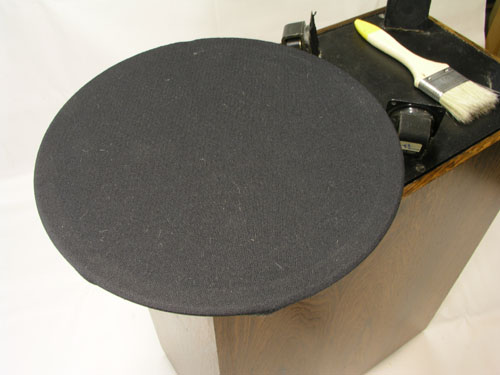
Left: Two renovated 9710 drivers, i.e. cone suspension
added a thin layer of flexible coating.
Right: I rarely have to sew making loudspeakers, but this
calls for a stocking of front grille cloth
as the drivers pointing upwards are true dust collectors.
.jpg) .jpg)
Right: Crossover is simplisity itself. 0.5 mH to the bass
drivers and a 2nd order filter for the tweeters
consisting of 6.8 uF cap and 0.5 mH coil.
I feel certain the crossovers are original as few diy'ers
would use wax for coating the coils. The film capacitor
(polyester) will probably last forever,
so no reason to change this with some PP that may not be
much better. The coil in series with the 9710 is from
pretty thin wire, but we're not
dealing with heavy loads of amperes here, so not much
would be gained from changing this one either.
Sonab OA5 mkII
cabinet
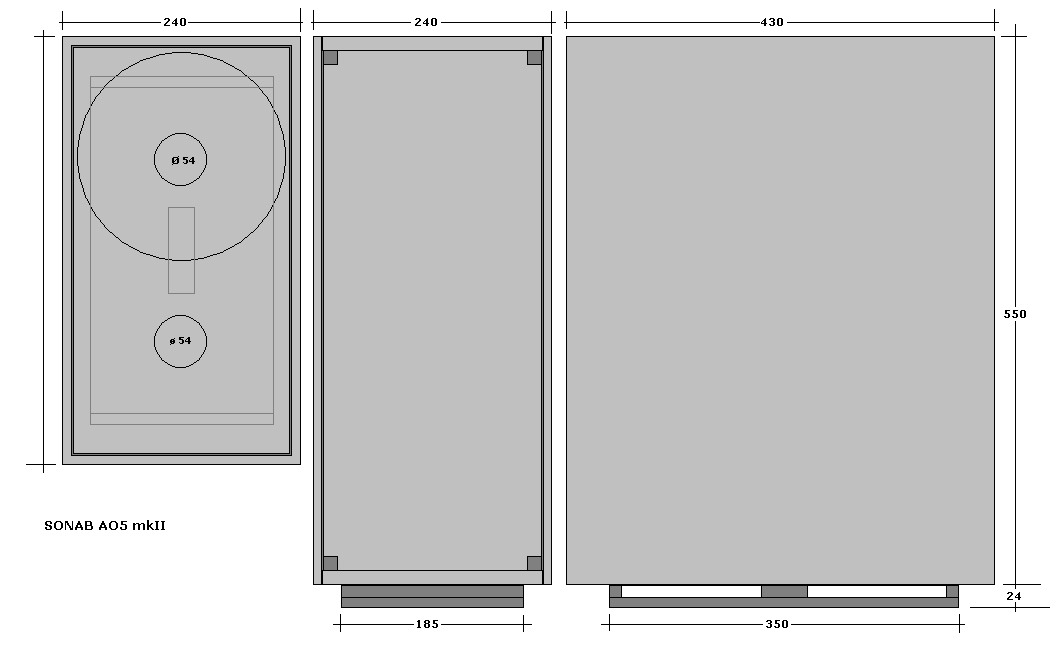
Cabs are made from thin
12 mm particle board veneered on both sides to
make an overall thickness of 13 mm. Bottom and
top are made from 16 mm particle board. A number
of fillets are placed inside to strengthen the
cabinet and damp resonances. Se photos above.
These cabs are lightweight! Some
10 kgs in total incl. drivers, crossover and
damping material and we may expect a highly
resonant system but this doesn't appear to be the
case. The bass quality is anything but boomy. Not
reaching deep, but short and fast, undoubtedly
due to overall construction and not least the
special use of damping material.
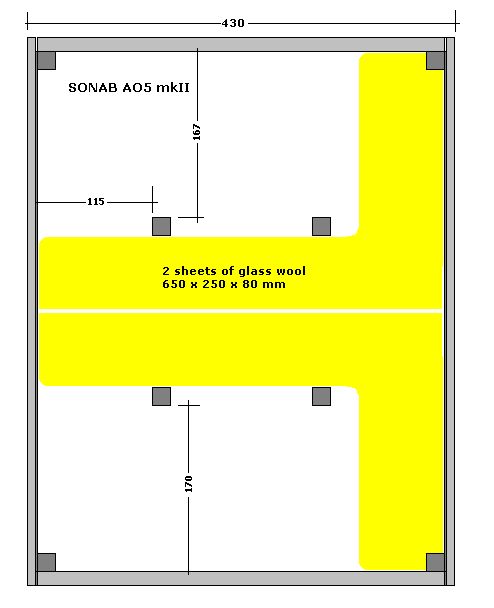
This is how the damping sheets are arranged in the
cabinet.
The 9710 driver is placed to the left here.
Cross braces are placed symmetrically.
Sonab OA5 mkII
crossover
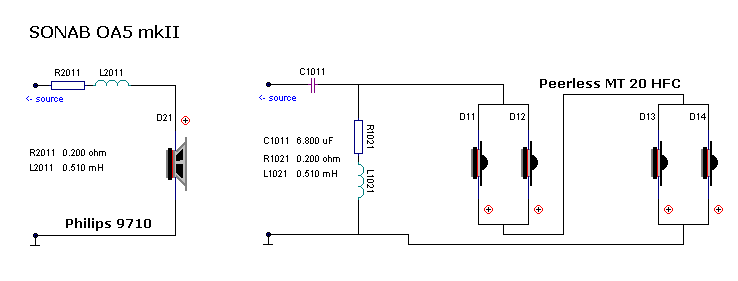
OA5 mkII crossover design, simplicity itself. 1st order
to the 9710 and 2nd order to the tweeters.
All tweeters are 8 ohms.
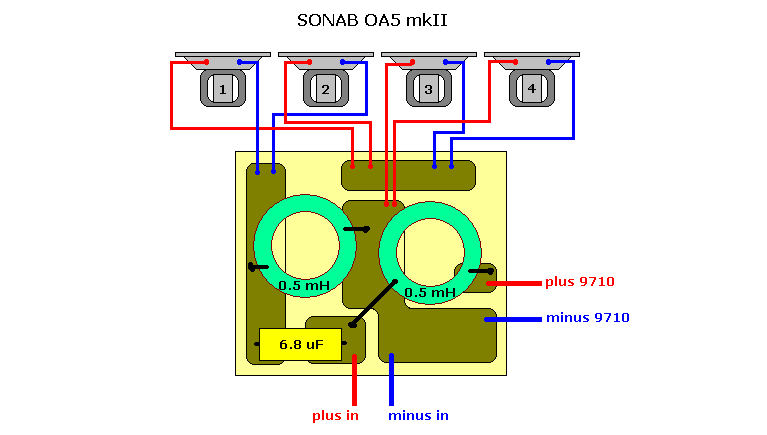
Crossover layout.
The PCB looks like the very first PCBs I made many years
ago with a marker
directly on the copper side before etching. That's what
made me wonder if
this speaker is a cleaver clone or the real thing.
Measurements
How on Earth
do we measure an omnidirectional speaker spewing
sound in all directions? Definitely not an easy
task and what's shown below is with every
possible reservation except for the impedance
measurements. At least these can't be argued.
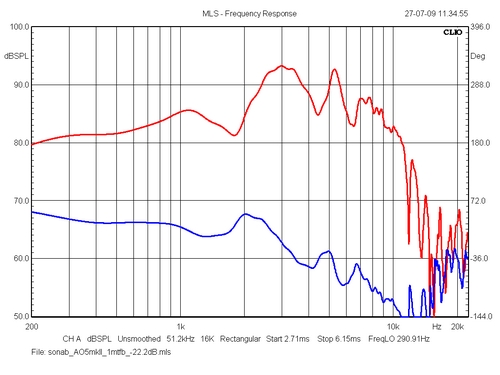 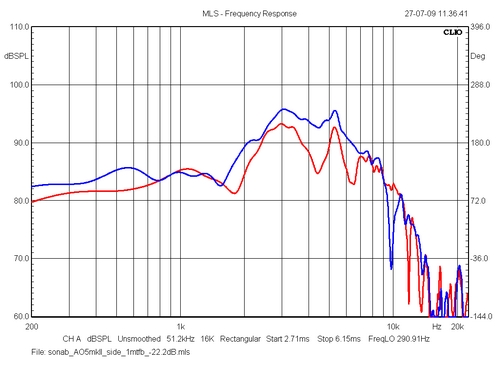
Left: Conventional gated measurement, 1
meter distance at 20 cm above top panel height.
Speaker placed like A (see below). Blue = minimum phase.
Right: Red = position A, Blue = position C.
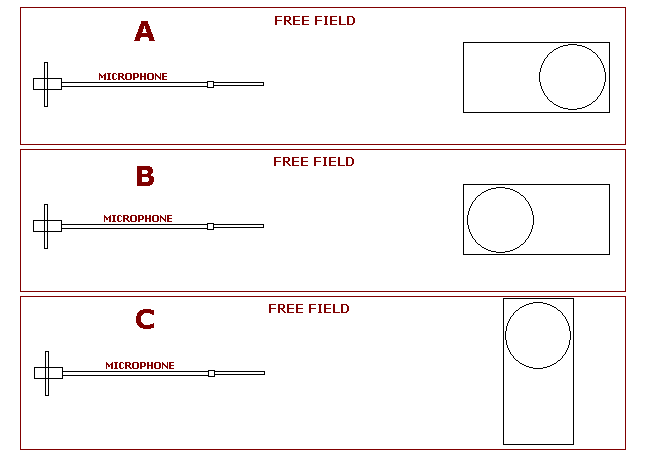
Various speaker positions during measurements. Position B
not shown here.
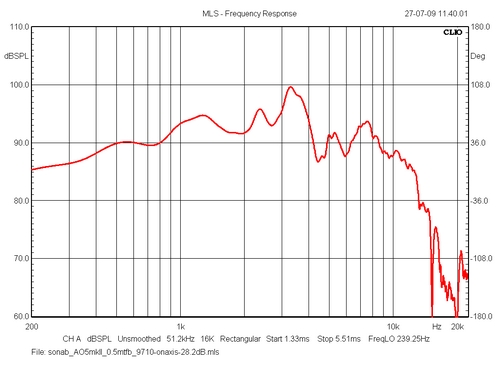
Here a measurement on-axis, 0.5 meter distance normalised
for 2.8V/1 meter.
System sensitivity is around 90 dB/2.8V/1m valued from
the response @ 500 Hz.
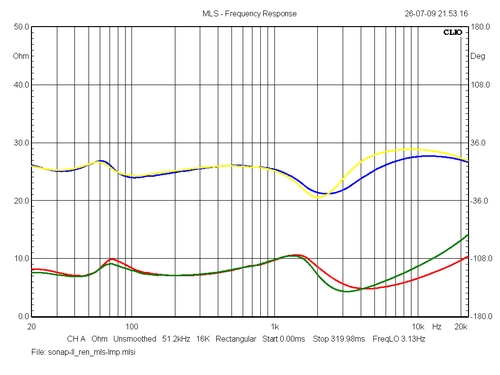 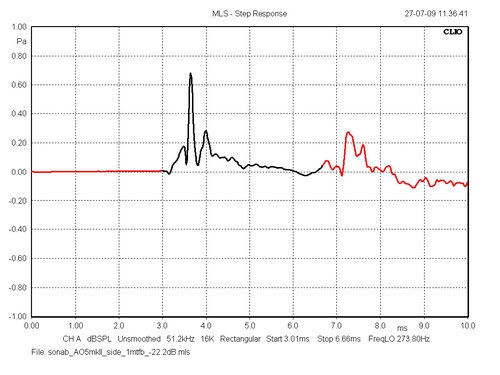
Left: Impedance of left and right speaker
showing decent bass tuning, i.e. placement of damping
material.
Right: Step response measured from position C (side).
The last four graphs are from various
measurements with speaker against a wall with different
distances to side wall.
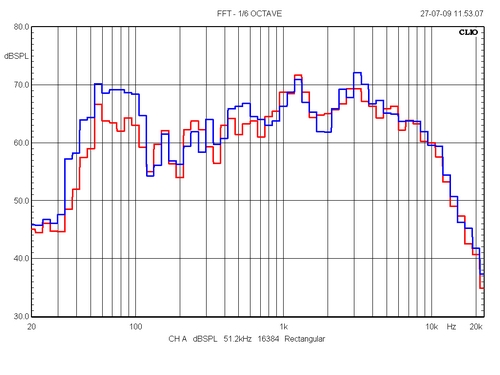 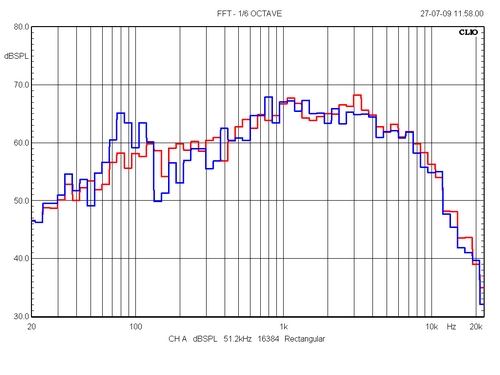
Left: 9710 side against
wall and 0.5 m to sidewall (blue) and 1.5 m to
side wall (red). Right: Tweeters against wall and
speaker 0.5 m to side wall and 1.0 m to side wall
(red). With the 9710 not up against the wall and
1 meter to side wall makes a decent smooth,
albeit seriously rising response. This is against
most recommendations I can find that will suggest
the 9710 being close to the wall, but this seems
to consistently produce a serious dip in the
~130-200 Hz range, something that will add to the
thinness of sound. It lacks weight as most music
has a lot of energy in this range.
By the way: These speakers do not say much below
50 Hz where the 37Hz claimed low-end extention
seems fairly optimistic. The heavy cabinet
damping is partly responsible for this. The 9710
can do better, but not at the same time produce
an impedance profile like seen here.
Final comments
Taking the Sonabs
to our living room I tried all possible
speaker placements. From our sofa, some 2½ meter
to the speakers, I found the speakers placed flat
against the rear wall to produce the best sound.
Having the speakers standing out from the wall
with either the 9710 or the tweeters against the
wall just didn't work. Phase tracking between
drivers is fairly good when I measure the
response on-axis, i.e. like measuring a
conventional speaker (data not shown), but
despite treble coming from all over the place,
having the drivers "on-line" appear to
compromise driver integration, thus flat against
the wall with a 20 cm distance between cabinet
and wall.
These speakers are quite
good at "making music in a
room" - if you get my meaning. Forget about
pin-point imaging and the like. Listening to the
ever-lasting Jazz at the Pawnshop, all the usual
details of rattling glasses and people speaking
is pretty much gone. Overall the sound lacks bass
and the middle and upper treble is dominant and
prevents you from turning up the volume, which
again will make the sound even slimmer as we do
need a certain loudness level to energize the
room. A drummer seriously hitting his cymbals...
let's be honest about the treble coming from 5
drivers in different locations, it just isn't
good from these speakers.
This may all sound a bit
negative, but I still think
omnidirectional speakers are interesting and I
may well give it a shot some day. The later Sonab
models with tilted midbas and quarter-circle of
tweeters may sound differently and seems more
like something that did address the issues
discussed above. Stig Carlsson's persistent work
on speaker and room integration is admirable to
say the least but this OA5 wasn't the final
answer to this most troublesome area.
Response to
article
Hi Troels,
Firstly, thanks for your web-site. I have really
enjoyed reading your articles over the past few
years. The first thing I do each day as I logon
to my PC is to check and see if there are any
additions to your web-site. You have provided a
great resource for the DIY community. Secondly,
your article on the Sonab speakers is very
interesting. I am hoping you continue to look
into omnidirectional speakers - the audio
community seems very divided on their merits,
however it seems that good omnidirectional
speakers have some very passionate supporters. I
found these reviews of the Shahinian Arc
speakers, which may interest you. I think the
Arcs use SEAS CA22RNY and 27TBF/G drivers.
The slope of the Arc front panel is consistent
with your comments about the later versions of
the Sonabs. Anyway, thanks for the great work.
Regards, Campbell A.
(Response from
Johan/Norway, suggesting this OA5 mkII is indeed
a kit version, which explains the missing badge.
Furthermore there should have been a mesh support
on top of the speaker and the 9710 basket for the
damping material was made from plastic in the
original. Thanks Johan for your comments.)
- jeg er også glad for det at du
har prøvd ut Sonab OA 5 mk II, og som
Carlssonentusiast vil jeg bemerke følgende. De
svake punktene gjengivelsen henger sammen med to
ting: foreldede elementer og manglende avstemming
av kassen. Både Philipsbassen og
Peerlesstweeterene har sine svakheter, og de kan
med fordel byttes slik dt er anbefalt på
Carlssonplanet og Faktiskt. Man kan også sette
inn et bassrefleksrør slik enkelte entusiaster
har gjort, med godt resultat. Det ser ut som du
har fått en kit-modell av OA 5 mk 2, altså et
hjemmebygg. Det går frem av dempekurven, som er
av plast i orginalen og av den manglende runde
pinnen som skal stikke opp mellom diskaneten på
orginalen. Hvis det mangler emblemer på fronten
også så er det nok temmelig sikkert et kit som
noen har laget. Jeg er av den overbevisning at du
har tenkt disse tankene, og jeg har et håp om at
du skal prøve ut en modernisert verson av OA 5
mk II. Igjen takk for mye intressant lesning! Mvh
Johan.
Hi!
It’s fun to read when somebody really looks
into to something. In your piece of the Sonab
OA-5 there are a few things that strike me as
odd. I think, as you already suspect, that these
are not the same as original factory-built units.
Some things look correct, others don’t.
Correct looking:
The box (the four side walls). The
damping-material and it’s position inside
the box.
Incorrect looking: The support for the net
between the tweeters is not there (see picture 1
below). The baffle it self looks strange but
perhaps it is just repainted. The crossover looks
like some I have seen on kits for the
“Pop-boxen” except for the capacitor
which is much newer than that. (Pop-boxen =
DIY-version of OA-5).
This damping basket looks like nothing I have
seen from Sonab, either it looks like picture two
below or it’s made of plastic on the ones
I’ve seen. The bottom of the speaker is not
as it normally is, perhaps the chipboard under
the speaker has been replaced. The DIN-plug is
also not original.
Perhaps this is a speaker that has
been refurbished with home-made parts?
Listening:
When you talk about your listening impressions
they don’t sound to me as the numerous pairs
I have had at home. They are normally not so
bright, rather the opposite! If you are standing
up close to the speaker they are of coarse very
bright since you then also get the direct
radiating sound from the speaker (9710). The
tweeters are often “hissing” producing
terrible “sssszzzssz” noise and the
bass is not too bad. With good tweeters they are
nice with Dire Straits and similar music. If the
tweeters are in working order but hissing you can
fix them somewhat, see:
http://www.carlssonplanet.com/renovation.php?lang=sv&. Scroll
down to: “Coata gamla diskanter” and
read on.
So my question is really if you have tuned the
damping-basket before listening / measuring?
There is a method to tune the basket for the
correct damping using a tone generator, a
volt-meter and an amp. If the damping basket and
its material is too tight you would get poor
bass. If you check out the download area of
CarlssonPlanet you’ll find three documents
that might be of interest if you have not already
seen them:
http://www.carlssonplanet.com/downloads/index.php?act=viewall. OA-5K
Broschyr. Popboxen – original article from
1964. Carlsson Ortho-Acoustic loudspeakers:
Design and Performance principles. Some are in
Swedish but I think you’ll manage. I hope
you will find something of interest in these
ramblings because I found your study interesting!
When somebody does something like this about
something that interests me I’m glad about
it. So I try to respond with some input of my
own. Would you like a copy of how the damping is
to be adjusted? Can the damping basket be
adjusted on your speakers?
Thanks a lot for the interesting reading, Martin.
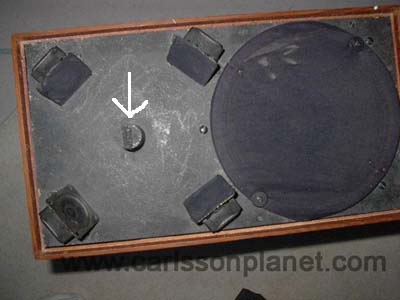 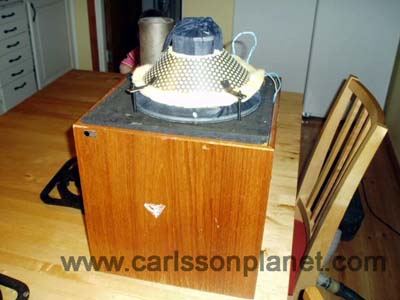
My
comments in bold:
Hej
Tack för din intressanta genomgång av Sonab
OA5.Tyvärr är det nog ingen
kit(byggsats)utan ett DIY. Flera detaljer talar
mot, t,ex
- Pinnen mellan diskanterna saknas
- Det ska vara en tygpåse (original
fjernet af mig da den var i dårlig stand)
- Det ska vara tätningslist under basen (original
fjernet af mig og erstattet med gummiliste)
- Basen ska var fäst med gummibussningar
- Det ska vara fästbyglar till diskanterna
- Baffeln ska vara försänkt flera cm
- Delningsfiltret ser inte rätt ut
- Kondensatorn är för modern (filmkondensatorer
fandtes længe før Sonab, så ??)
- Jodå,det ska finnas ett Sonab-märke
- Dämpkorgen har fel metallnät
Detta fann jag vid en snabb genomgång.Kan
precisera om du vill. Jag har några bilder från
kitet till Typ 1 om du är intresserad?
mvh, Rolf
Hej,
det här är vad jag har om OA5 kit.Obs att det
är typ1,men den stora skillnaden är
baffelns läge och ett högre galler.Bilderna är
scannade ur en tidning-TfA nr 18 1968. Konstigt
att inte någon enda människa tycks ha någon
byggbeskrivning i original kvar.Det såldes
ju massor....mvh Rolf

Click image to download 4 kit files (zip file,
3MB). Pics 2 and 4 from left taken from
carlssonplanet website on OA5 mkII.
Hi!
Nice to see that there is good response to your
article. I have also seen the article on the
9710, (Actually been considering to build he
cabinet with the two CT62 tweeters since I have
all parts lying around).
So I just planned to make a few clarifications to
my last mail:
- The support was mounted on the baffle when you
purchased the kit. (It’s not something you
add when assembling.)
- The idea with ”coating” is perhaps
incorrectly described, it is not about coating
the cone.The idea is to glue back he cone to the
basket. On old MT20 it sometimes starts to come
loose around the edges resulting in this terrible
hissing sound.If your tweeters are mint this
shall not be done since nothing then will be
gained!
- Regarding the adjustment of the basket I tried
to enclose it in the e-mail but it only came
back, so now I have uploaded it on CarlssonPlanet
under downloads instead.
Good luck! By the way, I just realised we have
had this E-mail conversation in English, would
Danish/Swedish be better?
Best regards, Martin
My comments:
The speaker tested in this article seems more in
accordance with the factory made OA5 mkII looking
at the photos on the carlssonplanet website.
Apparently the kit (OA-5 K) had recessed drivers,
i.e. top panel was lowered into the cabinet
making a flat top. However, the basket holding
the damping material below 9710 driver looks home
made. I'm pleased to see the bottom panel with
the two holes being in accordance with the kit
design, despite to speaker support looking
homemade too. The crossover looks OK being two
coils and a cap. The placement of damping
material seems OK.
All things equal, I believe that what I heard
here has been well in accordance with what an OA5
mkII customer heard back in the Early Seventies.
Having properly working drivers, correct
crossover and cabinet with correctly placed
damping materials, it can't go much wrong.
Thanks to all for contributing with comments and
pics on this interesting design. Regards, Troels.
And thanks for your second
mail, Martin. Having the Service Manual for the
OA5 mkII is great. Lots of details here.
Download manual from this link:
Service
Manual OA-5 Type 2 Loudspeaker
Best regards, Troels.
The Carlson/Sonab
Speakers you came across are not DIY but genuine,
I came across an identical pair in the mid
90’s working in a London 2nd Hand
HiFi Shop.
Ciao T
Believe it or not: My
neighbour has picked up another pair of Sonabs:
This time the
OA-14!
To be reported later this year.
|